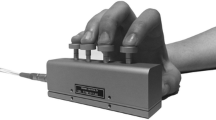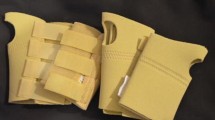Abstract
Hand motor deficits have been widely investigated, and several devices have been proposed for the selective and accurate study of specific hand motor tasks. Most studies have focused on the four, long fingers. The thumb function, although extremely important for the performance of most daily activities involving the hand, has scarcely been documented. A set of general-purpose, instrumental measuring devices has been designed and constructed at the authors' laboratory to measure and monitor the force each finger exerts separately, under isometric conditions, during pressing tasks. More generally, it is meant for the functional evaluation of the normal hand in different postures, but it also provides reliable measurements of the injured or deformed hand. The instrumental set is suitable for both biomechanical research and clinical applications. Effectively integrated with a visual feedback tool, it could be exploited in delivering and monitoring customdesigned rehabilitation programmes. The characteristics of the force transducers (range 0–100 N) were: inter-axis crosstalk <4%; non-linearity <±0.4% f.s.; hysteresis <0.3% f.s.; overall accuracy ±1% f.s. The overall measurement system resolution was better than 0.1 N, and the keys response to the mechanical shock (acquired at 10 kHz) showed a resonance frequency of about 1 kHz. It was observed that the thumb contributed more than 30% of the overall pressing force.
Similar content being viewed by others
References
Kilbreath, S. L., andGandevia, S. C. (1994): ‘Limited independent flexion of the thumb and fingers in human subjects’,J. Physiol.,479, pp. 487–497
Li, Z. M., Zatsiorsky, V. M., andLatash, M. L. (2000): ‘Contribution of the extrinsic and intrinsic hand muscles to the moments in finger joints’,Clin. Biomech.,15, pp. 203–211
Li, Z. M., Zatsiorsky, V. M., andLatash, M. L. (2001a): ‘The effect of finger extensor mechanism on the flexor force during isometric tasks’,J. Biomech.,34, pp. 1097–1102
Li, Z. M., Zatsiorsky, V. M., Li, S., Danion, F., andLatash, M. L. (2001b): ‘Bilateral multifinger deficits in symmetric key-pressing tasks’,Exp. Brain Res.,140, pp. 86–94
Reilmann, R., Gordon, A. M., andHenningsen, H. (2001): ‘Initiation and development of fingertip forces during whoie-hand grasping’,Exp. Brain. Res.,140, pp. 443–452
Santello, M., andSoechting, J. F. (2000): ‘Force synergies for multifingered grasping’,Exp. Brain. Res.,133, pp. 457–467
Schmidt, R. T., andToews, J. V. (1970): ‘Grip strength as measured by the Jamar dynamometer’,Arch. Phys. Med. Rehabil.,51, pp. 321–327
Author information
Authors and Affiliations
Corresponding author
Rights and permissions
About this article
Cite this article
Giacomozzi, C., Giansanti, D., Morelli, S. et al. New instrumental set for the assessment of the hand functionality. Med. Biol. Eng. Comput. 41, 513–515 (2003). https://doi.org/10.1007/BF02345311
Received:
Accepted:
Issue Date:
DOI: https://doi.org/10.1007/BF02345311




